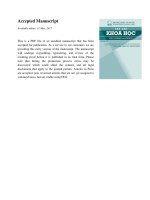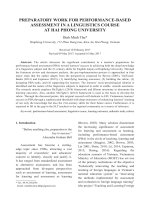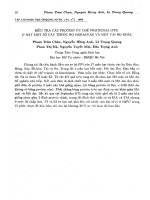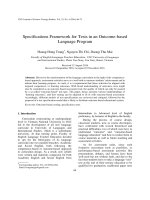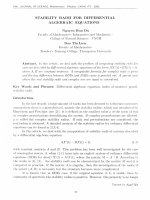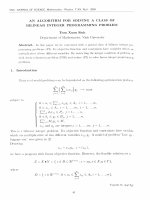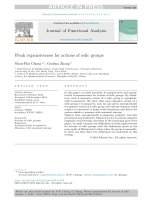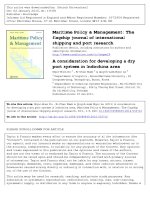DSpace at VNU: Stability radii for differential algebraic equations
Bạn đang xem bản rút gọn của tài liệu. Xem và tải ngay bản đầy đủ của tài liệu tại đây (3.55 MB, 12 trang )
VNU JOURNAL OF SCIENCE, Mathematics - Physics t XVIII. n°l - 2002
S T A B IL IT Y
R A D II
A L G E B R A IC
FOR
D IF F E R E N T IA L
E Q U A T IO N S
N guyen H un Du
Facility o f Mathematics, Inform atics and M echanics College o f Natural Sciences - VNƯH
Dao Thi Lien
Faculty o f M athem atics
Teacher'S Training College, Tlm inguyen University
A b s t r a c t . In this article, we deal with the problem o f computing stability radii f o r
systems described by differential algebraic equations o f the fo rm A X ' ( t ) + B X ( t ) = 0.
where A. B are constant matrices. A computable fo rm u la f o r complex radii is given
and the key difference between O D E s and D A E s cases is pointed out. A special casr
where the real stability radii and complex one are equal is considered.
K ey W ords an d P h ra ses:
stability radii.
Differential algebraic equation, index o f m atrices pencil,
Introduction.
Ill
the last decade, a large am ount o f works has been devoted to robustness measures
am ong them there is a powerful tool, nam ely the stability radius, which was introduced by
Hiiirichsen and Pritchart (see [2] ). It is defined as the sm allest value () o f the norm of real
or com plex perturbations destabilizing th e system . If com plex perturbations are allowed.
Ị) is called the com plex stab ility radius. If only real perturbations are considered, the
real radius is obtained. A detailed analysis of th e stability radius for ordinary differential
equations can he found in [2,3.4].
In this article, we deal w ith the com putation of stab ility radii o f sy stem s described
by a differential algebraic equation
A X ' ( t ) - B X { t ) = 0,
(1.1)
with constant, m atrices A and B . T his problem has been well investigated for the case
of nonsingular m atrix A. when (1.1) turns into an explicit sy stem o f ordinary differential
equations (O D E s for short) m
X ' ( t ) = M X ( t ), where the m atrix M = A 1B . According to
the works in [2]. [3]... the stab ility radii can be characterized by th e m atrix A/ and it is
com puted ill principle. If the m atrix A is singular, then th e investigation of the index of
the pencil {A , 13} is necessary but the situation becom es more com plicated.
It is known that ill O D E s case, if the original equation (1.1) is stable, then by
continuity of spectrum , the stab ility radius is positive. However, this property is no longer
T y p e s e t by
16
sta b ility radii fo r d ifferen tia l algebraic equations
IT
valid in tin* cas<‘ of différential algebraic equations (D A E s for short). T he mail! reason is
that tho structure of solutions o f differentia] algebraic equations depends strongly on the
indrx of (hr pencil {.4. B } and the solution s o f (1.1) have som e fixed com ponents. I nder
the perturbations, th e index o f the perturbed system s may he changed, that implies the
chauvin*; o ft hr dim ension of these fixed one and som e of eigenvalues may 1)0 ’‘disappeared"
which causr.s the stability radius of (1.1) perhaps to he equal to Ü. Moreover, it is different
to ODE.S case, in which we always arc able to find a dist urbance w hose norm equals to
stability radius Ị) and under which our system is unstable, such a m atrix ill DAEs case
may
not
exist .
Therefore, to study stability radii of algebraic differential equations, one* must pay
attention on th e index o f equation or the disturbances m ust having som e special forms
that we call structured perturbations in order to exclude “violent factors’*.
T hr article is organized rus follows: In th e next section, we stu d y som e basic prop(Ttk's of (inferential algebraic equations. Section 3 deals w ith a formula for com puting
the stability radius o f (1.1) where structured disturbances are considered.
Section 4 is
concernrd w ith a special class o f the pencil o f m atrices {A . 13} for which the com plex and
real stab ility radii are equal.
2. Preliminary.
C onsider Ĩ 111* equation
A X ' ( t ) - B X ( t ) = Ü.
where* A (•_
(2.1)
A and IỈ arc» constant m atrices in /\" ix m ,(/v = c or I \ — /?.), (let A = 0:
till* pencil o f m atrices {.4, B Ị is supposed to he regular, index {/1, D ) = k > 1. It is known
that there ex ists a pair o f nonsingular m atrices \ \ \ T such that
A .H -Ự '
“ ) r - ,
B = w Ợ 0'
/m°_ r ) r - ,
(2.2)
where / s is the unit m atrix in K sXs. Further B \ € I \ VX1\ u is a A:- nil potent matrix
having I.hr Jordan box form. i.e.. u = d ia g Ụ iy J ‘2 ,
./,=
/0
•//) w ith
°\
() 0... 1 e F l
\ 0
0...
(2.3)
0/
Midi that !n a X |< /< / p, = A: (see [5]). M ultiplying both sides of (2.1) by w ~ l wc obtain
whore T
lX( t ) = i
Y ' ( t ) - B ỴY ( t ) = (),
(2.4)
U Z '{ t ) - Z ( t ) = 0,
(2.5)
*Y(t ) € l \ ’\ Z ( t ) € K m~r . Since u is a k — liilpotent matrix.
it is easy to see th at th e equation U Z '( t ) — Z ( t ) = 0 has only a unique solution z = 0.
Thus, th e above system is reduced to
N guyen H u u Du, Dao Thi L ien
: "•
Y ' { t ) - D \ Y ( t ) = 0,
Z{t) = 0,
where Y { t ) € K ' \ Z ( t ) e K m~ r .
The trivial solution X = 0 of (2.1) is said to be asym p totically sta b le if there are
a certain projection p € C ( K m ) and p ositive constants a ,r . such that th e solution o f the
initial value problem
AX'(t) - BX(t) = 0,
P ( X ( 0) - X o ) = 0
is unique and the estim ate ||X (/)|| < c .||n X o ||i,_cvi, t > 0 holds. In fact, if th e index of
{A . 13} = 1 wc choose p — I — Q where Q is the projection OI1 h e r A along 5 = {z Ç c :
D z £ /m .4}.
We denote by a ( C , D ) th e spectrum o f the pencil {C\ D }, i.e.. th e set o f all solutions
of tlic equation (lot(AC - D ) = 0. In case c = / . we write sim ply rt-(D) for ơ ( Ị . D ) . It
is known that system (2.1) is asym ptotically stable iff all finite eigenvalues of the pencil
{.4 ./? } lie within the half left hand side o f com plex plan (see[5]). If ơ (A , B ) = 0 then
(2.1) lias only a unique solution X (f) = 0. Indeed, ơ (A , B ) = 0 im plies that for any
s. d('t(.s/l - B ) = dot w d e t ( s I(Ị ...fc — z?i)đet(ố*ơ - I ) d e t T ~ l = nonzero constant. Thus
(I A* = 0. i.e., th e equation (2.4) m ust be absent. Hence. (2.1) is equivalent to (2.5) which
lnus only a trivial solution X ( t ) = 0. In this case we also consider (2.1) is asym ptotically
stable by choosing p — 0.
3.
S t r u c t u r e d d is t u r b a n c e s .
As is clone ill O D E's case, one fixes a pencil of m atrices {A , B ) to be stable; a pair
o f m atrices E €
F 6 K q*m . and consider the disturbed system
A X ' ( t ) - (D + E A F ) X ( t ) = 0,
when* A £
(3.1)
. T he m atrix E A F is called structured disturbance. D en ote by
V k = {A € K pxq : (3.1) is either irregular or unstable }
i.e.. V/v is th e set of ubacT disturbance. Let d/t = in f{||A || : A € V/v}- W e call rf/v the
structured stability radius of th e quadruple { A , B, E , F } .
If K
= c , we have com plex
stability radius and if K = R we have real stab ility radius.
First, we investigate the com plex stab ility radius o f (2.1), i.e., K = c . Similar as
in ODEs. put G ( s ) = F ( s A — B )
1E and we shall prove th at
dc =
[sup
||G ( s ) ||] ~ l .
a€C*»
.We point out d c > [sup5eo l|G (5 )|ll~ l ‘ Taking A € V o, there are two cases:
a) T he pencil o f m atrices {A , B + E A F } is regular. T h en , we take a value s G
ơ (A , B -f E A F ) (it notes th at a (A , B -f E A F ) j=- 0 since A £ V c ). Suppose that x / 0
Stab ility radii fo r d ifferen tia l algebraic equations
is its corresponding eigenvector, that, is s A x — ( B + E A F ) x = 0. or equivalently, X =
(.S'/4 - B ) 1E A F . 1\ which follow s that
F
t
= F ịs A
B) l E A F x = G (* )A F x
Ị |A |Ị > | K ; ( . s ) r ' > ( sup ||ơ (.s-)|ir'
f o r a ll A • v< • w h ic h im p lie s t h a t (!(' > Ịs u p sẽ<:> l|G ( 's )ll]
h)
*•
Tilt* p m cil of m atrices {A . B ■+• E A F } is irregular, then for any s r
it exists
a vector .V =£ 0 such that .sAr - ( B + E A F ) x = 0. B v using a sim ilar procedure we can
prove d e > i.su|>M:.r . j|G(ü)i|]
W e now prove th e inverse relation d c <
.S(] G C " such that Ị|G(so)||
I I G M - ' . F o r a n y £ > 0. we find
1 < [supNícC;+ ||Cr(s)Ị|]“ l + £. Suppose th at u € C 7 such that
|w|| = 1 and ||G(#o)tt|| = ||G(*o)||. A corollary of Haln-Banach theorem follows that there
is a lineal' function y* defined on c p such that Ị|y*|ị = 1 and y*G($o)u = |(c?(s{))//II =
|ỊƠ(*o)||. Put A = ||G (s o )||~ l wy* € C V*'I. It is clear that
AG(S[))a = ||G(*0)|| ]uy*G(sị))u= ||C?(.So)Il ^J-IIG^o)!! = u.
Hence. ||A || > ||G (S())||~1. On the other hand, from A = ||G(.S())||_1 uy* we have? ||A || <
||6'(«o)|Ị 1• Therefore. IIAll = ||G(.Ç())|| V Further, since
AG(s{))it = a. we obtain
£A G («o)m = E v t 0. Let X :== (.SoA - then (.So/4 - z?).r = E u which fol
lows E A F r = (.So/4 - J3)t or (*{)A — B — E £ F ) x = Ü. i.e.. .So £ ơ { A A Ỉ -f* E A F ) . T his
means that th e system
A X ’{ t ) - ( B + E ă F ) X ( t ) = Q
is unstable. Therefore. A 6 vv*. Further,
dc- < ||A || = |i ơ (« o )~ l < [ sup \\G (s )\\)-1
s£C+
Because £ is arbitrary then d c < [supt, €^+ Ị | G » r ' . Thus,
dc = [ sup |ỊG (s)|ị]_ l .
«6 c+
We n ote th at the function G ( s ) is analytic on the half plan
then by maximum
principle, it only attain s m axim um at 6* = oc or on i R . Thus
dr = (sup||G(5)||]-‘ .
«€ IỈỈ
Following the above argum ent, we bee that if there exists So 6 c y such that
l| G f o ) ll = [s u p ’t r -
! I G ( * ) II ] th e n
d r = l|G (.S(,)ir1 = [ m a x ||G ( s ) ||] - 1.
N guyen H uu Du, Dao Thi L ien
Moreover, if tho m atrix A is given I)V
V
ă = \\F ( s 0A - B ) - ' E \ \
then A is '‘had'' matrix with 11All =
dcHowever, t he above argum ent does not allow us to com pu te a “bad” matrix A whose
norm oquals to
that (!(' — A and the system A X ' - ( B 4- E A F ) X = 0 is unstable. Suppose, ill contrary,
there is such a matrix A . Let .So € ơ ( A , B + E A F ) n C 4 and X is its eigenvector, i.e..
.s()Ar - ( B 4- E A F ) x - 0 which im plies th at ||AỊ| > ||G (so)ir~1 >
+ IK*(«o)||] 1 rr
dc- T his is contradiction.
Moreover, for any sequence (s ,i) in c * which m axim izes ||G(«sk)|Ị at oc and
associated to s„ is constructed as above (w e can suppose that there ex ists iim,,-»-* A ,, =
All. if not wo take a subsequence), then th e system ( A X ' — (13 -f E A ( ) F ) X — 0 is stable.
Since the set of matrices A such th at th e pencil o f m atrices { A . B + E i \ F ) has the index
1 is open then the index o f { A , B + E A ( ) F } must, bigger then 1.
We consider a special case where E = F = / (unstructured disturbances). A s is
s m i. till* stability radius w ith unstructured disturbances is
= [sup ||G (s)||]
sÇiK
1,
where G ( s ) — (sA
B ) l . We prove th at if in d (i4 ,/? ) = k > 1 then the matrix function
G(.s) is unbounded on i.R. Indeed.
as s —> “X . Therefore, ill this case, d c — 0. T his m eans t hat under a very small disturbance,
the DAEs with the index greater then 2 is no longer stable.
If ind(>4, D ) — 1. it is easy to prove th a t |ịơ(.s)|| is bounded oil
perhaps it (loos not exist any "bad” m atrix A such th at !|A|| = d c .
. i.e., d (7 > 0 but
Slim m ing up we obtain
T h e o r e m 3 .1 . n) The com plex sta bility ra dius o f System (2.1) is given by
d o = [sup ||G («)||] \
A' £ i f?
where. G ( s ) = F(.s/1 bj T h ere exists a “bad” m a trix A such that ||A || = d ç i f and o nly if G ( s ) attains
its m axim um over ỈR.
Stability radii fo r differential algebraic equations
21
c) hi the a ISC E = F — I , d c > 0 if a n d o n ly i f i n ả ( A s D) = 1 .
A question risrs Ihtc: whenever t he function ||G («)|| attains its maxim um at a finite
value *(,. \Y< firstly remark t hat th e answer depends strongly on th e chosen norm of C ' n
sinct* G ( s ) \ has maximum values in one norm but has not in another one. To sim plify
the situat ion. W(‘ solve the problem w ith A, B G R w and w ith a Euclid norm in the set of
m X HI m atrices, that is if M - ( u i i j ) i-s 3- w x m ~ m atrix then ||A /||2 =
(leal wit 11 the way to obtain t he decom position (2.2). First we decom pose (A — B ) ~ l A into
.Iordan form by a nonsingular m atrix 5 , that is (A - B ) l /l = S d i(u j( M , V ) S " X. where
r is a nilpotent m atrix of the form (2.3) and M is nonsingular. T he m atrix w and T in
(2.2) ih given by
ir
(.4
D )S d ia g (M J ):
T = S d i.a g { I,( V -
u = V (V - I)
1.
(3.2)
If G ( s ) is unbounded oil c \ then A c = 0 and there is no th ing to say. The
assum ption G’(.s) to he bounded im plies that F T d ia q ( Q .U J ) \ V ~ [ E = 0 Vj > 1. Thus
G {s ) := F T d i a y { ( s I - B ị )
[ . { U - / r 1) ^ - 1# = F T d i a g { ( s I - B i ) - \
L e t / ( * ) = :: ơ ( i / . s ) ị | ,J i f 6* Ỷ u a n d / ( 0 ) = 1ÌI1Ì.V-+OC | | G ( l / s ) | | 2 (w e r e m a r k t h a t th is
limit always exists). It is easy to see that
f ( s ) = ||FTdm//(s(/ —si?i) 1, —I ) W 1E\\~.
Since all entries of the' m atrix G ( s ) are only rational functions which are analytic
then by th e maxim um principle, th e maxim um of G ( s ) takes place only at s = oc or
s G iR . Therefore, G (s ) attain s its m axim um at s = 00 iff /(.at s = 0 (of course we consider only s in c t+). Thus, taking a ray Í —> t • e, t > 0 where
= (c o sn . sin a ).
< a < “ , the attainm ent of m axim um value at 0 of /(.s) implies
that //(()) < 0. for every c. It is easy to see that
//(0 )
where c
= 2 cos a [FTrftasf(0, - / ) W r * £ ] * [ í T d t a p í A O ) ^ " 1^ ] = 2 c o s a C * D ,
= [F7Vi/a<7(Q, —I ) W ~ l E ] : D = [FT ,d ia ịf(/, 0 ) i y “ !£ ] and C' * D denotes the
Frobenius inner product of two m atrices C , D .
In using the expressions o f w and T ill (3.2) we obtain
c : = F T d ia g [0 , - I ) \ v
lE
= F T d ia y iO , ư ( ư - / ) ■ ' - / ) w ' £ = F T d ia g { 0 , V - I ) W
XE
= F S d ia g ( J . ( V - I ) ~ l ) ■diag(Q, V - I ) d i a g { M ~ l , I ) S ~ l { A - B ) ~ l E
= F S d ia g ( 0, 7 ) 5 “ *(i4 - B y 1E
and
D : = F T d i a g ( 1 , 0 ) V I 1£ = F T W ~ l E + C
= F S d ia ợ ( I , ( V - / ) - 1)d ia $ ( M ~ l J ) S ~ l [A - B ) ~l E + c
= F[Sdìag(M, V - I ) S ~ l] - l {A - B ) ~ l E + C
= F[(.4 -
B ) l A - Sdiag(0,
/)5 - l )-1(i4 - JB)-1JE + C
= F U - (/1 - ổ ) S í/m ổ ( 0 , / ) S - 1]" 1£ ’ + C'
Nqxtyen H u u D u, D ao Thi L ien
2 2
Sum m ing up, we have: if c * D > 0 then G ( s ) has m axim um a t a finite value s. In
the case c * D = 0 we can com pute higher derivatives o f / to obtain the answer but the
formula is com plicated and we do not realize here.
E x a m p le
1.
Let us calculate stab ility radius o f the structured perturbed equation
A X ' ( t ) -- ( B 4- E A F ) X ( t ) = 0 where A is disturbance and
0
1
0
/1
.4 -
0
V»
1\
1
0/
-2
B =
-1
V -1
-1
-1
Ü
0
0
-1
E =
It is St»011 t hat hid ( A B ) == 2 and
tot.icallv Stable. By a direct com putation we obtain
G (s) = F (s A - B ) ~ l E =
T hus. \\G{s)\\ — 3 m ax{|
3.s-f 1
•m
3.s-f 1
$
3.9+1
3s-f 1
«4 i
3*4-1
.s
3*-f 1
3s4 1
*+1
3s +1.
Al
3 ü 'f 1
ị Ị} which attain s its m axim um at So = 0 and ||C (0)|| =■
|, ị
3. Hence. d(' = 1/3. C hoose u = ^ 1 ^ then ||G (0)u|| = (7(0) = 3. Let y* = (0 1 0). we
/0
have A = ijC7(0)II 1 uy* = I 0
1 /3
1 /3
\()
1/3
0\
0 I . Moreover, đet(.s/l - B - JSA F) = 2.S = 0 for
0/
s = Ü.
E x a m p le 2. Let us consider the equation /LY'(£) - J3X (i) = 0 where A = ^ 2 *
and B =
^ *2
()**)’ ^
seen
(.S/1 - Ữ) 1 = f ,s/ ^Sỵ 2 ^
1/ 4 ) '
~
Ơ{ A , B ) — - 1 .
and G (s) —
H ence- \\G(S)\\ = m a x { 3 / 4 ,l / 2 + |s / ( s + 1)1} which
d oesn ’t attain its m axim um on c 4 . Further, lim.'-too ||G (s)|| = 3 /2 . i.e.. A c = 2 /3 . If we
choose Ü =
^
is large. T hus, with y* = ( 1
A = ||G (s)|Ị“ Siy* =
y , it is clear th at ||u|| = 1 and ||G (s)tz|| = |ị
converges to
^ 2^3
o)
30
6
00 ■
It is easy to verify d e t ịs A - D - A ) = - 8 / 3 for all s, i.e., ơ ( A , - ( / ? + A )) = 0 and
th e equation A X f(t) — ( B + A ) X ( t ) = 0 i.e.. the system
/
/ 5
—X I2j* > — ~X] -f* 2 x 2 = 0
3
4
2 x\ — 4 4 + -X j = Ü
«J
sta b ility radii fo r differential algebraic equations
has a unique solution ./'I - 0: ./*•> = 0 which is asym ptotically stable.
4 . T h r e q u a lit y o f real a n d c o m p le x s t a b ilit y r a d iis o f D A E s
In I his section, wo are concerned with a special case where* the com plex stability
radius is equal to real stability radius. For DAEs. this is a difficult question because under
th e action of the pencil of m atrices ị A. D ) . the positive cone ÌĨ+ is no longer invariant even
both A and B arc positive. We arc able to solve problem under a very strict hypothesis.
Suppose th at A. 11 c. IV "* '".
A m atrix I I ~ (n, j ) c f í " íXn‘ is said to 1)0 positive if (\,ị > 0 lor any i . j . D enote
[ho nbsolutr o f tin- m a t r i x M =
by \M = (IM ill) a n d o f the vector ./• by I./•; —
{ ../*!». ./J ......Ị.r„, ị). Wo define a partial order relation ill ftmxnt by
A/ < N & M - N < 0.
L e t //(/1 , IỈ) b e t h e a b s c i s s a s p e c t r u m
o f t h e p e n c il { - 4 ./? } . i.e .. f ỉ ( A . B ) : =
111H X { ‘}ỈÀ
: A €
a (A J i)}.
We consider the* equation
4 X (/)-Z Ỉ À '(0 = 0 ,
(4.1)
where w4. /Ỉ are constant m atrices in /?,,ixm . the pencil {.4. £?} is regular. ĩf’ iii(H A . B ) > 1
then thero is nothing to say because d c = (Ifi = 0. So we suppose that in d (A , B ) = 1 and
the following conditions are satisfied:
i) A > 0
ii) There exists a sequence (/.„): t„ > 0; tu
oc such th at ( t „ A - D )
(4.2)
1 > 0 for all
».
( 4 .3 )
iii) T he equation (4.1) is asym p totically stable.
\ \ v remark that the above conditions ensure a positive system oil O D E s case.
Let us choose the m onotonous norm in R ,n. T hat is. if \x\ < ịt/l then I'./’ll
|Ị/y||.
Let the system (4 .1) satisfies above conditions , then for till X such that
'RA > fi(A , D ), we have I(A.4 - B ) X I < (5iAi4 - 2?) Ịarị for any X € /?"*.
L e m m a 4 .1 .
Proof. Let us take an t, tn € /? such th at / > /í(A , £?).and
- 1 > iu {A yD). Suppose
that. A = /.-H u, we have to prove th a t !((/: -f i u ) A — B ) 1.rị < (tA - B ) 1\x\ for all X € R ni.
By sim ple calculation we have
((t + iaj)A
Putting G ( t „ ) — (t „ A
B) 1 = ( t „ A - B ) - l [ I - { t n - t - k j ) A ( t „ A - B ) - i \ i .
B)
1. we obtain
Ị(í + iw )A - B ) } - 1 = G ( t n) [ I - (tn - t - iü j) A G ( t u) } J
X
< ? ( * „ ) £ ( « „ - i - « j ) n(A G (i„ ))" .
(4.3)
71=0
The above series absolutely converges if we can prove th at ||(£„ - t - y’u;)r(i46t(f/,))|| < 1
where r ( M ) denotes tlu* spectrum radius of M .
N g u yen H uu D u , Dao Till L ie n
21
First, it is easy to see th at lim ttÈ-4oo(tn - \tn - t
=■ t. Therefore, for e =
i fi{A . B ) > 0 we have in - Iỉn - t - iuĩ\ > t - e = ụ (A . B ) for tn sufficiently large, i.e..
t„ ụ (A . B ) > \tu - i —
On the other hand, by hypotheses i) and ii), A G ( t „ ) i‘s positive
matrix, tIll'll I)V Perron-Frobenius theorem : r ( A G ( t n )) = n ( A G ( t fl)) € ơ ( A G i1 fl)). T his
means that cletjr(/4 G (/„ ))/ — A G ( t f1)) = 0. Hence.
(let [ r ( A G ( t n ) ) I - A G ( t n )} = 0 « d e l[(tnA - B ) - A / r ( A G { t n ))\ = 0
« det[(in - i / r ( A G ( t n ) ) ) A —J5] = 0.
Thus. t„ - (-(/t(.4 (-?-yy 6 a ( A . B ) . Therefore, r i À G ù - t" ~ M-4 ’ # ) - which implies |/„
/ - 7u;|r(i4G(in )) < 1. Hence, by (4.3)
|((i + L i ) A - B ) - ' x I < G ( t n) J 2 \tn - t - úư)|” (> 4 ơ (í„ ))M|3:|
nssO
= G ( t „ ) \ I - |*„ - t - i< j\(A G (t „ )}--] \x\ = \(tn - |t„ - t - M M - B ] - ' |x |.
Let t„ ~> oc we obtain
|[(/ + iu>)A - Ơ]' ‘x| < ( t A - B )
1|;r|.
Lemma 4.1 is proved. Ộ
L e m m a 4 .2 . G (t ) = (M - B y 1 > 0 for any t > fi(A . D ). M oreo ver , G (/) is decreasing
on (fi(A . B ), oc).
Proof. Let t() > fi(A , D). By using Lem ma 4.2 we see th a t |G(*o)| 5: G(ỈR/u) = G (tị))
t hen G ịtị)) > 0.
The decreasing uf G (t ) on
J3), oc) follows from the first part of th e Irmma and
the fact that for s .t > ụ ( A %D ) one has G ( s ) — G (t ) = (t — s)G (.s)i4G (£). Ộ
Because the function G ( s ) is analytic oil half plane c + then it only attains maximum
at s — oc or s £ iR . Furthermore, m onotonous norm is chosen then by Lemma 4.1 G(.s)
attains the m axim um on [O.oo). On th e other hand, by Lem m a 4.2, it follows th at G (s )
hap its maxim um at t = 0. i.e.. ||G (0)|| = rnax{||G (A)|| : ?RA > 0} = IIB 1II.
From Perron - Frobenius theorem , there ex ists u > 0, \\u\\ = 1 such th at ||G’(0)//|| =
;jCV(0) . By using once more H aln-Banach theorem for positive system there exists positive
linear functional y* satisfying y*(G (0 )n ) = ||G (0)u|| ^ 11^(0)11 all(ỉ \\y*\\ = 1- Let A
ỊỊGT(O)II { utj* > 0. Following th e way as above we can prove th a t A is “bad” matrix and
|ỊA|| = d r . Therefore,
T h e o r e m 4 .3 . Suppose that the system (4.1) satisfies hypotheses i); ii) and Hi) and a
monotonous norm in R m is chosen, then the com plex sta bility radius d c and the real
stability radius (in are equal and (In = (IIB- 1 )!!- 1 .
As is m entioned above, assum ing the p o sitiv ity o f G ( t n) for a sequence (tn ) is
strong and it is difficult to verify.
We know give a sufficient condition to ensure the
Stability radii fo r differential algebraic equations
*»Ih>\v liv p o t 1|(‘S<\S. It is s a id t h a t th e s y s te m ( 2 .1 ) is p o s it iv e i f f o r a n y :/•() € IV " =
( / / I . / / J .......//,!,) : //;
'• n w — 1 . 2 ........ ?/ /}. th e s o lu t io n X f w i t h X () =
{y =
i f i t e x is ts , s a tis fie s
the condition .V/ > 0 for all / > 0. Lot Q he a projection on K e r A then it is known that
(2.1) is equivalent to
A" - zLy = 0 :
Q X = 0.
(1.4)
w lin r. ộ
Q(,4
ÜQ) 1/?; p = 1 Q and D = P (i4 We note that Q (loos
not depend on thí» choice of the projection Q and P ( A - B Q ) ~ l = P (A — Ỉ.ÌQ) Ỵ which
implies tlirif 13 is independent of the choice of Q. So it is seen that (2.1) is positive if and
only if p > 0 and D is a P - M etlez matrix, i.e.. all entries o f B are positive except for
rut ries h,j with p,j > 0. where p = (p ij). Indeed, from (4.4). the general solution of (2.1)
is Xf — exp(/ữ)PÀ '<|. Thus, the p ositivitv condition im plies that p > 0 (w ith t = 0). On
tilt* other hand, for / is sm all wo h a w
0
v . x Ị ì{ t ở ) r = / • +
= P + f B + o(t),
t -* TC
as
/ft-I
which follows that if
P 'J
= 0 then bij > 0. Conversely, if B is a P — M etlez matrix then ill
noting that p is a projection which com m ute w ith B then for an a such that o P + D > 0
wo lia VO
e x p ( t B ) P = exp ( - c t t P + t ( B + a P ) ) P = ex p ( - a t P ) ex p ( t ( B + ( \ P ) ) P
= e x p (“ Or£)exp(f(B + a P ) ) P > 0.
w v now suppose that the system (2.1) is positive. In adding conditions that P ( A -
B Q ) 1 > 0 and Q { A B Q ) 1 > 0 we can prove that G (t) = ( tA - B ) ~ { > 0 for any t > 0
and / large*. To verify this attestation we have only to remark that
BQ)
(/1
‘ (//1 - B ) = t P - (yl - B Q ) ~l B = t P + Q - B
= ( P + £ . / / ) [ ' / - (P -M Q )i? ] = ( P + Q / t ) ( t I
B)
Thus.
ơ(/) =
[(,1
= (//
£ (-})
( M - / ; ) ] ■ '( / ! - B Q )-‘ =
[(P + Q / f ) ( / / - Ỗ ) j
Ồ) 1P ( i 4 - B Q ) - I + í ( í / - Ỗ ) “ 1ộ ( i 4 - / ĩ ộ )
‘ (/ 1
BỘ)
1
1
= (/ - B Y 1P ( A - B Q ) - ' + Q ( A - B Q ) - 1.
Since B is a p - M etlez then there is a f() such th at (t — B )
(4.5)
1p > 0 for any t > t().
Thus, under the hypotheses P (i4 — B Q ) ~ l > 0 and Q ( A - B Q ) ~ l > 0. the relation (4.5)
tells that G (f ) > 0 for t > t{).
However, it is easy to give an exam ple w here th e system is positive but the resolvent
(tA - B ) 1 is not positive. So far we do not know if the positive condition ensures the
equality o f (!(' and (//,». An answer of this problem is welcome.
N g u yen H uu D u, D ao Thi L ien
We consider the case where G { s ) attains m axim um at s = oo. From th e relation
(4.5) we see that
.Inn
||G (s)|| =
s Ç C + . s - ï - x .
\\G(t)\\ = \\Q(A - B Q ) ~ l \\ = m ax ||G (.s)||.
J im
t e R + - , t - +
oc
where Q: B are given as in (4.4). Let (/.„) be a sequence in (0, 00 ) such th at linin _>.x.
•X. For any n we choose u n € R m and y* w ith (y?ả) r G
such th a t
= 1 WVnW =
1: |ỊG (f„)ỉ/„|| = ||G (/„ )|| and y * (G {tn) u „ ) = |ỊG (í„)itrtị| as in §3. Let A „ = ||G (/„ )|ị l u n -y’,
It is clear that t-n is an eigenvalue o f th e pencil {A , 13 + A ,,} w ith the corresponding
eigenvector .vn = (in A - B ) ~ xUn. T his means that A n £ Vft. It is easy to see that.
liin„ ^ IIA,,11 = lim,,-*-* liG (fM) ||_1 = d('. i.e., d o = d R . T hus,
T h e o r e m 4 .4 . I f the resolvent. G ( s ) has not maxim um value on the right-hand half of
complex pliUi then d c — Drt-
E x a m p le 1.
C om pute th e stab ility radius of the system A X ' ( t ) — D X (t .) = 0 with
ịf i
0
\
0
1
0
1r - 2
1
1VO
°i
0
!
1
-1
u
0 \
1
- 1 /
It is seen th at ind {A , B ) = 1; ơ (A , B ) = { - 3 / 2 - \/5 /2 ; “ 3 /2 H- \/5 / 2 } and
/1
0
\0
Thus
0
1
0
0\
0
:
/
ồ =
0/
is P - M etlez. Moreover.
Q(i4
/0
- B Q ) Ê= I 0
\0
Then G ( s ) > 0 for any
0 0\
1 0
0 1/
> 0; P (A
- B Q r 1=
/1 0 0 \
0 1 1 I > 0
\0 0 1
£> 0 and it attain s the maxim um at .So = 0 w ith
( l
0 { 0) = 1
\0
1 l\
2
0
2
;
\j
and
||G (0)|| = 5.
Therefore. (In = d c — 1/5 = ||A || where
0 1 /5
A = I 0 1 /5
0 1/5
0
0
0
sta b ility radii fo r differential algebraic equations
References
1. V. Dragan.
T h e A sym ptotic Behavior of the Stability R adius for a Singularly
Perturbed Linear System . International Jo u rn a l of Robust and N onlinea r Control.
8(1998). 817-829.
2. D. Hinricheseii and A.,I Pritchard. Stability Radii of Linear System s. Sys. Contr.
L e t. 7(1986).4-10.
3. D. H inrichesen and A.J Pritchard. Stability Radii for Structured Perturbations and
the A lgebraic Riccati Equations Linear System s, Sys. Contr. Let., 8(198(5). 105-113.
4. D. H iuridisoii and N.K. Son. Stability Radii of Positive D iscrete-T im e System s un
der Affine Param eter Perturbations. International Jo u rn a l o f Robust and N onlinear
Control. 8 (1998). 1169-1188.
5. R. Mar/.. Extra-ordinary Differential Equation . A ttem p ts to an analysis of Differ
ential Algl'hraic System . Preprint No 97-8. Humboldt IJniversitat Zu Berlin (1997).
(). TL. Q uill. H. BtTiilumlsson. A. Rantzer. E-.l. Davison. P.M. Young and .I.e. D oyle.
A Formula for Com putation of the Real Structurod Stability R adius, Autornatica.
31 (1995), 879-890.
TAP CHI KHOA HOC ĐHQGHN. Toán - Lý. t XVIII. n°l - 2002
B Á N K ÍN H Ổ N ĐỊNH Đ ố i VỚI C Á C PHUƠNCi TR ÌN H VI P H Â N ĐẠI s ố
Nguyẻn Hữu Dư
Khoa Toán Cơ Tin học , ĐH Khoa học T ự nhiên, ĐHQGỈ Ỉ N
Đào Thị Liên
Khoa Toán, Đại học Sư phạm Thái Nguyên
T r o n g b à i b á o n à y c h ú n g tỏ i đ ề c ậ p đ ế n v iệ c tín h b á n k ín h ổ n đ ịn h c h o hệ đ ư ợ c
mỏ tá bới phương trình vi phán dại số có dạng
m a trậ n h ả n g số .
AX'(t)
+
BX(t)
= 0, trong cỉó a, b là các
M ộ t c ô n g ih ứ c b ấ n k ín h ố n đ ịn h p h ứ c d à đ ư ợ c đ ư a ra và sự k h á c b iệ t
giữa các trường hợp phương trình vi phân thường và phương trình vi phàn đại sổ cũng
đ ư ợ c c h i ra . C h ú n g t ô i c ũ n e n g h iô n c ứ u trư ờ n g h ợ p đ ặ c h iệ t m à ờ đ ó b á n k ín h ố n đ ịn h
th ự c v à v à p h ứ c b à n g n h a u
